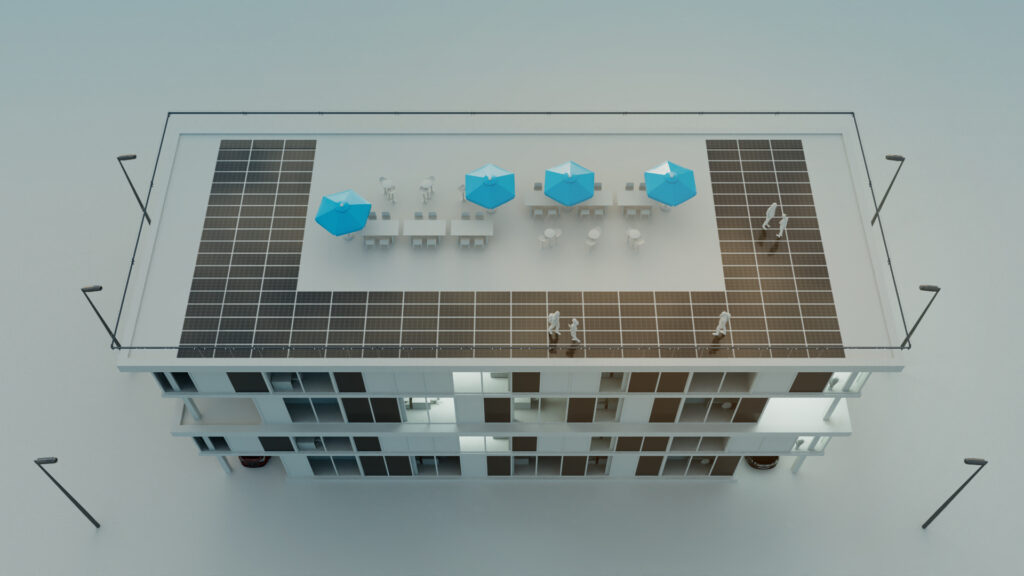BIPV Technology or Building-Integrated Photovoltaic Solar Energy consists of incorporating different types of solar panels or photovoltaic modules into the structural elements or façade of a building, transforming them into renewable energy generators for solar self-consumption.
This innovative solution is characterized by its sustainability in the construction of both the present and the future.
The replacement of traditional building materials is becoming more common with BIPV technology. We invite you to explore this fantastic world with us in the following article.
What is Solar Photovoltaic Energy or BIPV Technology in Solar Self-Consumption?
BIPV modules function similarly to different types of solar panels used in traditional systems: they capture sunlight and convert it into electricity through a process called the photoelectric effect. This energy can be used to power the building or be injected into the electrical grid.
This technology involves the integration of photovoltaic modules into the facade or structure of a building, allowing for efficient solar self-consumption. The traditional materials that this technology replaces are based on roofs, windows, cladding, and more.
Additionally, the building’s aesthetics become more uniform and attractive once this new technology is applied.
Types of solar panels or BIPV technology for solar self-consumption
Crystalline Silicon Photovoltaic Modules
They are the most common and efficient, ideal for roofs and large surfaces.
Thin-Film Photovoltaic Modules
Lighter and more flexible than crystalline silicon modules, but slightly less efficient. Perfect for facades and curved applications, allowing solar self-consumption in more complex spaces.
Photovoltaic Modules Integrated into Roof Tiles
They blend seamlessly with traditional roof tiles, making them ideal for residential rooftops.
Photovoltaic Modules Integrated into Glass
Ideal for windows, skylights, and facades, allowing natural light to pass through.
Semi-transparent BIPV Solar Panels
Widely used due to the significant amount of sunlight they allow to pass through. They create a natural lighting effect in the space.
Applications of BIPV Technology
The applications of this new technology are very diverse. It can be implemented in different types of buildings, such as:
Residential buildings
Including apartments, duplexes, townhouses, or single-family homes.
Commercial buildings
Including buildings where commercial activities take place, such as hotels, shops, offices, and large shopping centers.

Industrial buildings
Large distribution centers, warehouses, logistics hubs, factories, production, and distribution centers.
Public buildings
Schools, hospitals and health centers, libraries, universities.
We can also see BIPV technology applied in other constructions such as greenhouses, urban furniture, and canopies.
Advantages of BIPV technology for solar self-consumption and the role of the types of solar panels

Compared to traditional photovoltaic systems, BIPV technology offers several advantages, including the following:
Aesthetics
The appearance of the building or its facade changes completely once BIPV technology is applied. The appearance becomes more attractive.
Cost Reduction
Costs can be reduced in terms of building materials and installation expenses, thanks to the integration of different types of solar panels or photovoltaic modules into the building’s structure. Solar self-consumption also enables significant energy savings, up to 40% over the building’s lifespan.
Spatial Efficiency
The application of this new technology does not require additional space, as it utilizes the space already occupied by the building’s construction. It increases its efficiency by 10-20%.
Greater Efficiency
BIPV modules are less exposed to the elements. This can result in greater efficiency compared to traditional solar panels.
Environmental Benefits
Promoting the use of renewable energy or reducing greenhouse gas emissions are some of the practices encouraged by BIPV technology. It can reduce CO2 emissions by up to 70% compared to traditional buildings.

The Future of Photovoltaic Solar Energy or BIPV Technology
BIPV technology is positioned as a key construction method for the future. It opens the door to a wide range of possibilities for building more efficiently and sustainably.

New Materials
To carry out construction with this technology, new materials are being explored to bring innovation to building outcomes Among these are perovskite cells or amorphous silicon. The goal is to achieve greater flexibility, efficiency, or lightness.
New Applications
The applications of this technology go beyond roofs or building facades. Among these innovations, we can find greenhouses, urban furniture, and more.
AI Intervention
Artificial Intelligence is at the forefront of today’s technology, and its link with BIPV is no exception. AI will be integrated to improve performance and efficiently manage demand.
Social Awareness
There is significant social awareness about sustainability and the need to address it. This boom will drive the demand for buildings constructed with BIPV technology. both from consumers for personal use and from businesses.
BIPV and Microgrids
Buildings constructed with BIPV technology will be able to integrate into microgrids and create more sustainable and resilient local energy communities.
BIPV and Energy Storage
Greater potential for self-consumption and less dependence on access to the electrical grid are some of the advantages that can arise from the connection between this technology and energy storage systems.
Regulation and Public Policies
BIPV technology should be promoted by governments and international organizations through support programs, new measures, regulations, incentives…
The rise of BIPV technology is here: transform your space and join the clean energy revolution!
At Solum, we are pioneers in BIPV and are committed to sharing our knowledge and experience with you. We offer you expert advice, cutting-edge technology, and comprehensive solutions.
What are you waiting for?








